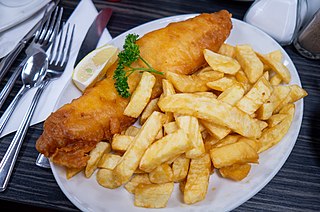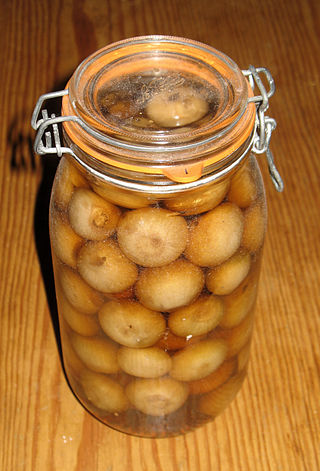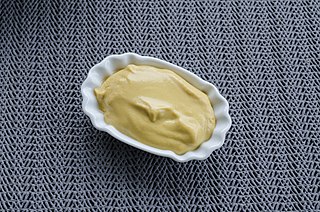Non-brewed condiment is a malt vinegar substitute created with water, acetic acid, flavourings and often caramel colour, generally used in fish and chip shops in the United Kingdom and Ireland. [1] [2] It is also used in salads.
Traditional vinegars are made by fermenting alcohol (wine, in the case of wine vinegar; cider for cider vinegar; and an ale made from malted barley in the case of malt vinegar). All of the colours in the vinegar are from natural sources, and the fermentation process requires time.
Non-brewed condiment is acetic acid mixed with colourings and flavourings, making its manufacture a much quicker and cheaper process than the production of vinegar. According to Trading Standards in the UK, it cannot be labelled as vinegar or even put in traditional vinegar bottles if it is being sold or put out on counters in fish-and-chip shops. [3]
According to Arthur Slater, writing in the August 1970 edition of Industrial Archaeology , the Chief Metropolitan Magistrate ruled in a 1949 prosecution at Bow Street Magistrates' Court that the term non-brewed vinegar, which up until then had been used to market such acetic-acid solutions, was in contravention of the Merchandise Marks Act 1926 as it constituted a false trade description. The decision was upheld on appeal to the King's Bench Division. Slater goes on to state that after the unsuccessful appeal the trade association concerned announced that in future their product would be sold as non-brewed condiment. [4]

A drink or beverage is a liquid intended for human consumption. In addition to their basic function of satisfying thirst, drinks play important roles in human culture. Common types of drinks include plain drinking water, milk, juice, smoothies and soft drinks. Traditionally warm beverages include coffee, tea, and hot chocolate. Caffeinated drinks that contain the stimulant caffeine have a long history.

Vinegar is an aqueous solution of acetic acid and trace compounds that may include flavorings. Vinegar typically contains from 5% to 8% acetic acid by volume. Usually, the acetic acid is produced by a double fermentation, converting simple sugars to ethanol using yeast, and ethanol to acetic acid using acetic acid bacteria. Many types of vinegar are made, depending on source materials. The product is now mainly used in the culinary arts as a flavorful, acidic cooking ingredient, or in pickling. Various types are used as condiments or garnishes, including balsamic vinegar and malt vinegar.
Acetic acid bacteria (AAB) are a group of Gram-negative bacteria which oxidize sugars or ethanol and produce acetic acid during fermentation. The acetic acid bacteria consist of 10 genera in the family Acetobacteraceae. Several species of acetic acid bacteria are used in industry for production of certain foods and chemicals.

Fish and chips is a hot dish consisting of fried fish in batter, served with chips. The dish originated in England, where these two components had been introduced from separate immigrant cultures; it is not known who combined them. Often considered Britain's national dish, fish and chips is a common takeaway food in numerous other countries, particularly English-speaking and Commonwealth nations.

A condiment is a preparation that is added to food, typically after cooking, to impart a specific flavor, to enhance the flavor, or to complement the dish. A table condiment or table sauce is more specifically a condiment that is served separately from the food and is added to taste by the diner.

Mother of vinegar is a biofilm composed of a form of cellulose, yeast, and bacteria that sometimes develops on fermenting alcoholic liquids during the process that turns alcohol into acetic acid with the help of oxygen from the air and acetic acid bacteria (AAB). It is similar to the symbiotic culture of bacteria and yeast (SCOBY) mostly known from production of kombucha, but develops to a much lesser extent due to lesser availability of yeast, which is often no longer present in wine/cider at this stage, and a different population of bacteria. Mother of vinegar is often added to wine, cider, or other alcoholic liquids to produce vinegar at home, although only the bacteria is required, but historically has also been used in large scale production.

Biltong is a form of dried, cured meat which originated in Southern African countries. Various types of meat are used to produce it, ranging from beef to game meats such as ostrich or kudu. The cut may also vary being either fillets of meat cut into strips following the grain of the muscle, or flat pieces sliced across the grain. It is related to beef jerky; both are spiced, dried meats; however the typical ingredients, taste, and production processes may differ.

A fish and chip shop, sometimes referred to as a chip shop or chippy, is a restaurant that specialises in selling fish and chips. Usually, fish and chip shops provide takeaway service, although some have seating facilities. Fish and chip shops may also sell other foods, including variations on their core offering such as battered sausage and burgers, to regional cuisine such as Greek or Indian food.

Pickled onions are a food item consisting of onions pickled in a solution of vinegar and salt, often with other preservatives and flavourings. There is a variety of small white pickled onions known as 'silverskin' onions; due to imperfections they are pickled instead of being wasted. They are frequently used as an essential component of the Martini cocktail variant known as a Gibson.

Apple cider vinegar, or cider vinegar, is a vinegar made from fermented apple juice, and used in salad dressings, marinades, vinaigrettes, food preservatives, and chutneys. It is made by crushing apples, then squeezing out the juice. Bacteria and yeast are added to the liquid to start the alcoholic fermentation process, which converts the sugars to alcohol. In a second fermentation step, the alcohol is converted into vinegar by acetic acid-forming bacteria. Acetic acid and malic acid combine to give vinegar its sour taste.

In food processing, fermentation is the conversion of carbohydrates to alcohol or organic acids using microorganisms—yeasts or bacteria—under anaerobic (oxygen-free) conditions. Fermentation usually implies that the action of microorganisms is desired. The science of fermentation is known as zymology or zymurgy.

Cider is an alcoholic beverage made from the fermented juice of apples. Cider is widely available in the United Kingdom and the Republic of Ireland. The UK has the world's highest per capita consumption, as well as the largest cider-producing companies. Ciders from the South West of England are generally higher in alcoholic content. Cider is also popular in many Commonwealth countries, such as India, South Africa, Canada, Australia, and New Zealand. As well as the UK and its former colonies, cider is popular in Portugal, France, Friuli, and northern Spain. Germany also has its own types of cider with Rhineland-Palatinate and Hesse producing a particularly tart version known as Apfelwein. In the U.S. and Canada, varieties of alcoholic cider are often called hard cider to distinguish it from non-alcoholic apple cider or "sweet cider", also made from apples. In Canada, cider cannot contain less than 2.5% or over 13% absolute alcohol by volume.

Acetic acid, systematically named ethanoic acid, is an acidic, colourless liquid and organic compound with the chemical formula CH3COOH. Vinegar is at least 4% acetic acid by volume, making acetic acid the main component of vinegar apart from water. It has been used, as a component of vinegar, throughout history from at least the third century BC.

Traditional balsamic vinegar is a type of balsamic vinegar produced in Modena and the wider Emilia-Romagna region of Italy. Unlike inexpensive "Balsamic Vinegar of Modena" (BVM), Traditional Balsamic Vinegar (TBV) is produced from cooked grape must, aged at least 12 years, and protected under the European protected designation of origin (PDO) system, fetching higher prices. Although the names are similar, TBV and the inexpensive imitation BVM are very different.

Mustard is a condiment made from the seeds of a mustard plant.

Acetobacter aceti is a Gram-negative bacterium that moves using its peritrichous flagella. Louis Pasteur proved it to be the cause of conversion of ethanol to acetic acid in 1864. It is a benign microorganism which is present everywhere in the environment, existing in alcoholic ecological niches which include flowers, fruits, and honey bees, as well as in water and soil. It lives wherever sugar fermentation occurs. It grows best in temperatures that range from 25 to 30 degrees Celsius and in pH that ranges from 5.4 to 6.3. For a long time it has been used in the fermentation industry to produce acetic acid from alcohol. Acetobacter aceti is an obligate aerobe, which means that it requires oxygen to grow.